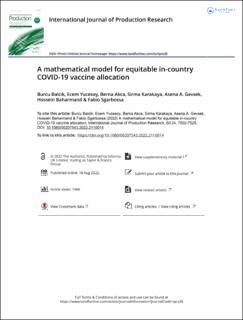| dc.contributor.author | Balcik, Burcu | |
| dc.contributor.author | Yucesoy, Ecem | |
| dc.contributor.author | Akca, Berna | |
| dc.contributor.author | Karakaya, Sirma | |
| dc.contributor.author | Gevsek, Asena Ayse | |
| dc.contributor.author | Baharmand, Hossein | |
| dc.contributor.author | Sgarbossa, Fabio | |
| dc.date.accessioned | 2023-01-09T07:24:01Z | |
| dc.date.available | 2023-01-09T07:24:01Z | |
| dc.date.created | 2022-08-04T09:18:08Z | |
| dc.date.issued | 2022 | |
| dc.identifier.issn | 0020-7543 | |
| dc.identifier.uri | https://hdl.handle.net/11250/3041719 | |
| dc.description.abstract | Given the scarcity of COVID-19 vaccines, equitable (fair) allocation of limited vaccines across the main administrative units of a country (e.g. municipalities) has been an important concern for public health authorities worldwide. In this study, we address the equitable allocation of the COVID-19 vaccines inside countries by developing a novel, evidence-based mathematical model that accounts for multiple priority groups (e.g. elderly, healthcare workers), multiple vaccine types, and regional characteristics (e.g. storage capacities, infection risk levels). Our research contributes to the literature by developing and validating a model that proposes equitable vaccine allocation alternatives in a very short time by (a) minimising deviations from the so-called ‘fair coverage’ levels that are computed based on weighted pro-rata rations, and (b) imposing minimum coverage thresholds to control the allocation of vaccines to higher priority groups and regions. To describe the merits of our model, we provide several equity and effectiveness metrics, and present insights on different allocation policies. We compare our methodology with similar models in the literature and show its better performance in achieving equity. To illustrate the performance of our model in practice, we perform a comprehensive numerical study based on actual data corresponding to the early vaccination period in Turkey. | en_US |
| dc.language.iso | eng | en_US |
| dc.publisher | Taylor & Francis | en_US |
| dc.rights | Navngivelse 4.0 Internasjonal | * |
| dc.rights.uri | http://creativecommons.org/licenses/by/4.0/deed.no | * |
| dc.title | A Mathematical Model for Equitable In-country COVID-19 Vaccine Allocation | en_US |
| dc.title.alternative | A Mathematical Model for Equitable In-country COVID-19 Vaccine Allocation | en_US |
| dc.type | Peer reviewed | en_US |
| dc.type | Journal article | en_US |
| dc.description.version | publishedVersion | en_US |
| dc.source.journal | International Journal of Production Research | en_US |
| dc.identifier.doi | 10.1080/00207543.2022.2110014 | |
| dc.identifier.cristin | 2041065 | |
| dc.relation.project | Norges forskningsråd: 312773 | en_US |
| dc.relation.project | Universitetet i Agder: 464989 | en_US |
| cristin.ispublished | true | |
| cristin.fulltext | postprint | |
| cristin.qualitycode | 2 | |

